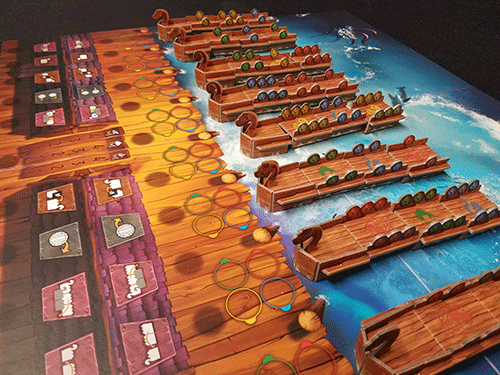Vikings on Board Review
on Jul 28, 2016
Vikings you say? Although they are definitely present, this family title isn’t about pillaging or plundering. Instead, Vikings on Board is about provisioning the ships that are going off to raid. Four clans are vying for control and access to the best goods. Plus, they like to gamble.
The board is taken up by a large sea space. On that space, there are eight ships docked. Each ship has a bow which holds goods and then three body spaces. Those body spaces belong to one of the particular clans and can hold one to three shields. A stern piece is added only when the ship launches. It’s a really cool-looking game. The ship pieces are 3D cardboard bits. They are a fun to manipulate and extremely eye-catching on the table. Play in public and you’re likely to get some interested looky-loos.

The rest is all worker placement. The players take a number of different spots. There are spots that let you swap around the body pieces, bet on who has control of a ship when it launches, and even add goods to ships. And one action allows you to launch a ship at the end of the round. Once launched, the players determine how many shields of each player are there. The one with the most gets first choice of goods on the ship. Then the next player chooses and so on around the table. Then, that ship is then out of the game. The game ends when seven of the eight ships have been launched. At that point, the players count up the value of their bets and goods and the one with the most points wins.
The most interesting aspect of Vikings on Board is the turn order. You see, the actions are in line from least useful to most. So at the beginning of the order are things like “go first next turn†and “move one of your boat pieces up for a tie breaker.†Meh. Towards the end, though, are the really powerful abilities like “swap any two boat pieces on boats†or “choose which ship launches.†Huge! But in the next round, the players take their turns in the order of actions from previous rounds. So, I might take the tie breaker action this round, and that would let me go early next round whereas if I took the swap action, I’d be going last next round.
With that said, going last isn’t so bad. The game has a strong area (well, ship) control element. And like all area control games, it’s good to have the final turn before scoring. That way you can mess things up to your advantage and other players won’t be able to undo all your hard work.
Vikings on Board handles two to four players and feels very different at each player count. All of the boat pieces are always used. So without four players, there will be neutral clans who nevertheless may get control of a boat. Plus, the number of players determines how many workers you get. Two players get four workers apiece. But four players get only two each. This hugely impacts how much you can do on a turn and how chaotic the game feels.
The most important action, though, is the launch-a-ship action. It provides a double edged sword to the player. On the one hand, it gives you near-total control. You can launch any ship you want, provided it has at least one good on it. So it puts that player in the role of kingmaker. They basically get to decide who gets the most points and who will lose access to their body pieces for the remainder of the game.
But the restriction that they have to launch a ship with at least one good is important. You can’t just send your opponents’ pieces into oblivion with nothing. And if I take the ship action, that means I’m down one worker as compared to everyone else. So once a player takes the ship action, the other players might quickly fight to control one of the few ships with goods, or add goods to another ship to try and get that one chosen.
You can take the launch-a-ship action any time. But you don’t actually launch until the end of the round. That means that, once you take that ship token, all the other players have the opportunity to scurry about and mess everything up. Suddenly, instead of launching your awesome ship full of goods, you will be launching a ship that some other player controls - much less enticing. In the early game, this action is avoided because there aren’t enough choices. But it can be a hotly contested and extremely powerful action in the mid to late game.

Although it’s billed as a family style game, I might be hesitant playing with family. Someone might work hard to control a particular ship, and then another player might mess it all up with a swap action. If your family has thin skin and doesn’t like to see their plans aggressively disrupted, then this title might not fit. Otherwise, Vikings on Board does a good job of producing tricky choices in a simple package and can easily be grasped and enjoyed by non-gamers and gamers alike.

 Customer Support
Customer Support  Subscribe
Subscribe 




 Account
Account  Wishlist
Wishlist 

